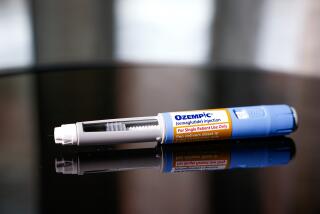Town Tries to Take a Stand Against Childhood Obesity
- Share via
As parents, doctors and government officials debate how best to intervene in the epidemic of obesity among American children, a few schools are taking matters into their own hands--to the dismay of some pediatricians.
The Northern California school district of Hollister--like communities in Pennsylvania and Florida--sends letters home to parents of overweight or seriously underweight kids in kindergarten and grades two, five and eight, recommending that the children be seen by a doctor and change their diets.
For the record:
12:00 a.m. June 24, 2002 For The Record
Los Angeles Times Tuesday June 18, 2002 Home Edition Main News Part A Page 2 National Desk 11 inches; 401 words Type of Material: Correction
Doctor’s title--In Monday’s Health section, in a story on the Hollister, Calif., school district’s attempt to combat pediatric obesity through parental notification, the specialty of Dr. Francine Kaufman was incorrect. She is head of pediatric endocrinology at Childrens Hospital Los Angeles.
*
For The Record
Los Angeles Times Monday June 24, 2002 Home Edition Health Part S Page 3 Features Desk 2 inches; 76 words Type of Material: Correction
Physician’s specialty--In another June 17 story, on the Hollister school district’s attempt to combat pediatric obesity through parental notification, the specialty of Dr. Francine Kaufman was incorrect. She is head of pediatric endocrinology at Childrens Hospital Los Angeles.
The letters go out when children fall above the 95th percentile for height and weight, compared with 100 of their same-sex peers, or below the 5th percentile.
Parents or guardians are informed that “continuation of this growth pattern may result in serious health problems, such as heart disease, diabetes and/or malnutrition.”
A bill that would mandate parental notification statewide is pending in Sacramento. AB 1905--introduced by Assemblyman John Longville (D-Rialto) and passed by the Assembly--would require California school districts to measure junior-high students’ height and weight and inform the families of any children who are at risk for diabetes.
The measurements would be conducted at the same time as checks for spine curvature, called scoliosis.
But experts say such letters could be an empty gesture--possibly even making matters worse if the children feel stigmatized.
Many kids may not have a regular doctor or access to health care, and some parents resent the intrusion.
Carol Kemp, a school nurse in the mostly agricultural community of Hollister, defends the letters, which were her idea.
Although the school district doesn’t follow up or ask parents to report back, she said: “I’m hoping that it’s raising awareness, and hopefully we can do more.”
The Hollister district, south of San Jose, began reporting worrisome results to families three years ago.
*
School officials routinely measure children’s growth, Kemp said, but “it doesn’t do any good to measure kids and weigh them unless they [parents] know what the results are.”
“The first year we got a lot of irate parents,” she said. “Last year we actually had some parents thank us for the letters.”
This year, the parents of underweight kids were the ones who complained.
Hollister’s program was a response to a growing number of local kids with Type 2 diabetes.
Five years ago there were only a couple of diabetic kids in the 2,300-child district; today there are more than 20, Kemp said.
Hollister is located in San Benito County, which outranks every other county in childhood obesity, she said.
“They’re focusing on the wrong thing. Focusing on the kid’s body is the perfect way to make eating disorders,” according to Dr. Marc Jacobson, a specialist in adolescent medicine at the Schneider Children’s Hospital Center for Atherosclerosis Prevention in New Hyde Park, N.Y.
“They’re singling out certain kids, but from what we know about the obesity epidemic, every kid is at risk. They’re all eating poorly and not getting enough physical activity.
“They have to focus on habits and have to teach every kid--whether they’re skinny or normal weight or fat--how to eat right and how to have some sort of exercise they can do for life, just like they teach basic math or reading.”
*
Dr. Francine Kaufman, head of pediatric oncology at Childrens Hospital Los Angeles and the incoming president of the American Diabetes Assn., welcomes programs that raise family awareness about the links between obesity and disease, but called the letters home “ridiculous until we can offer something for the families that might want to do something about it.”
The sale of junk foods in the schools--not to mention scaling back physical education instruction--”is part of the reason these kids have gotten obese. Until we can determine--and there are some National Institutes of Health studies underway--the best way to do this, it may be premature.”
Kemp said Hollister schools are trying to encourage kids to exercise more by rewarding those who walk or run the track at lunch or during recess.
She also said that the schools have been trying to take the highest-fat foods out of the snack bar, “but it’s really controversial because the school makes money selling snacks to kids. We’ve just started looking at what we can do to help.”
More to Read
Get the L.A. Times Politics newsletter
Deeply reported insights into legislation, politics and policy from Sacramento, Washington and beyond. In your inbox three times per week.
You may occasionally receive promotional content from the Los Angeles Times.










